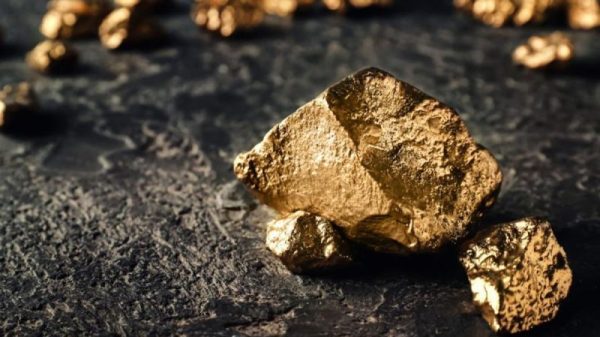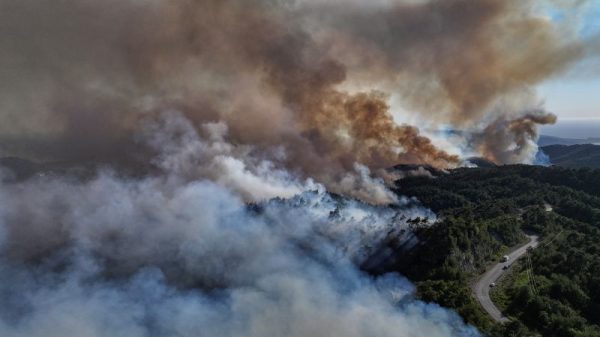A pristine asteroid sample that could serve as a time capsule from the early days of our solar system has finally been revealed.
The rocks and dust contain water and a large amount of carbon, said NASA administrator Bill Nelson, which suggests that asteroids may have delivered the building blocks of life to Earth. The sample is nearly 5% carbon by weight, making it one of the highest concentrations of carbon to be studied in an asteroid, according to Dr. Jason Dworkin, OSIRIS-REx project scientist at NASA’s Goddard Space Flight Center in Greenbelt, Maryland.
“Far exceeding our goal of 60 grams, this is the biggest carbon-rich asteroid sample ever returned to Earth,” Nelson said. “The carbon and water molecules are exactly the kinds of material that we wanted to find. They’re crucial elements in the formation of our own planet. And they’re going to help us determine the origin of elements that could have led to life.”
The sample, collected from the 4.5 billion-year-old near-Earth asteroid Bennu in October 2020 by NASA’s OSIRIS-REx mission, arrived on Earth in a capsule on September 24, dropping from the spacecraft and landing in the Utah desert.
Since then, scientists have been hard at work studying the wealth of material — more than they expected — just inside the top of the canister to conduct an early analysis. The results of that analysis, and the first look at the sample, were shared during a live NASA broadcast from the agency’s Johnson Space Center in Houston on Wednesday. It’s the largest asteroid sample returned to Earth.
There was so much “bonus” material when the scientists opened the canister that the team has yet to open the bulk sample.
A ‘treasure chest of extraterrestrial material’
Over the past two weeks, the science team analyzed some of the rocks and dust using a scanning electron microscope, taking infrared measurements and conducting a chemical element analysis. They also used X-rays to create a 3D model of one of the particles to reveal its composition, revealing a “scientific treasure” of carbon and water content, said OSIRIS-REx principal investigator Dante Lauretta.
“The first analysis shows samples that contain abundant water in the form of hydrated clay minerals, and they contain carbon as both minerals and organic molecules,” Nelson said.
The team shared detailed images of the particles revealing the water-bearing clay minerals.
“That is how we think water got to Earth,” said Lauretta, who is also a University of Arizona Regents Professor of Planetary Sciences. “The reason that Earth is a habitable world, that we have oceans and lakes and rivers and rain, is because these clay minerals landed on Earth 4 billion years ago to 4 and a half billion years ago, making our world habitable. So we’re seeing the way that water got incorporated into the solid material.”
The analysis also revealed sulfide minerals, “a critical element for planetary evolution and biology,” iron oxide minerals called magnetite that react to magnetic fields, and other minerals that could be important for organic evolution, Lauretta said.
The science team was excited to detect organic matter and a wealth of carbon, which is an essential element for all life, said Dr. Daniel Glavin, OSIRIS-REx sample analyst and senior scientist at NASA’s Goddard Space Flight Center.
“We’re just beginning here, but we picked the right asteroid, and not only that, we brought back the right sample,” Glavin said. “This stuff is an astrobiologist’s dream.”
Going forward, the team will look to see just how much chemistry evolved on Bennu to determine whether the building blocks of life created peptides, or chains of amino acids that form proteins, Glavin said.
Meanwhile, still waiting inside of the canister is “a whole treasure chest of extraterrestrial material,” Lauretta said.
What the sample could reveal
When the OSIRIS-REx spacecraft closely approached Bennu three years ago, it extended a Touch-and-Go Sample Acquisition Mechanism head, or TAGSAM, toward the asteroid and fired a blast of nitrogen gas. The burst of gas lifted rocks and dust all the way from 19 inches (50 centimeters) beneath the space rock’s surface. That debris flowed into the TAGSAM head.
The TAGSAM also had 24 surface contact pads that touched the asteroid and trapped fine-grained material.
The device has been removed from the capture ring, sort of like removing a boot from a ski, Lauretta said. During the removal, material slipped out of the TAGSAM flap, a check valve designed to keep material inside the sample collector. The flap struggled to close due to some rocks that kept it open after collecting the sample in 2020. The rocks measure a couple of centimeters at the longest, he added.
Over the next couple of weeks, the curation team will continue to carefully disassemble the TAGSAM head to reach the bulk sample within. Once they do, the team expects to have a good estimate of the entire mass of the sample.
Together, the dust and rocks collected from Bennu’s surface and its interior could reveal the history of how the asteroid formed and evolved over time. These insights will also shed light on the space rock’s overall composition, which could help NASA determine how it might deflect the asteroid, which has a chance of impacting Earth in the future.
The much-anticipated reveal has been seven years in the making, from the OSIRIS-REx mission’s launch in 2016 to the capsule landing last month. Some have looked forward to the moment for even longer. Lauretta, who helped develop the mission during its earliest stages, has waited nearly 20 years to see the sample and glean the insights it might reveal about our solar system.
“Our labs were ready for whatever Bennu had in store for us,” said Vanessa Wyche, director of NASA’s Johnson Space Center. “We’ve had scientists and engineers working side-by-side for years to develop specialized gloveboxes and tools to keep the asteroid material pristine and to curate the samples so researchers now and decades from now can study this precious gift from the cosmos.”
Scientists will analyze the rocks and soil for the next two years at a dedicated clean room inside Johnson Space Center. The sample will also be divided up and sent to laboratories around the globe, including OSIRIS-REx mission partners at the Canadian Space Agency and Japanese Aerospace Exploration Agency. About 70% of the sample will remain pristine in storage so future generations with better technology can learn even more than what’s now possible.
“Rocks tell you a story,” Lauretta said. “The greatest mystery that we’re facing right now is, how do you go from a ball of mud to something that’s alive? When do you make that transition? The deepest desire is that we’re going to make some progress in trying to figure out why is it that we’re here in this universe.”





























